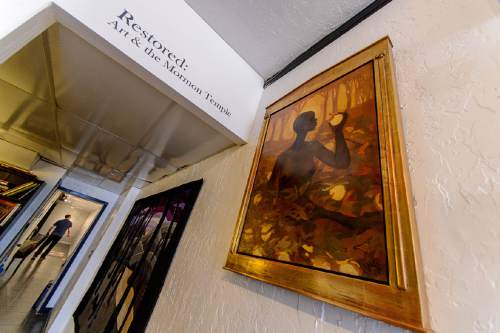This is an archived article that was published on sltrib.com in 2016, and information in the article may be outdated. It is provided only for personal research purposes and may not be reprinted.
For months, Mormon painter J. Kirk Richards' stunning portrait of a black Mother Eve has been hailed for breaking racial boundaries in the world of LDS art.
In Richards' work "Eve and the Fruit of the Tree of Knowledge," an African woman stands amid a pile of leaves in a lush forest, staring at the glowing, bitten apple in her hand. The woman is naked from the waist up, her dark breasts and round nipples prominently displayed. Sun is shining through the trees to illuminate the scene.
Now the white artist is encountering criticism — not for painting a black Eve, but for how he depicted this nude black woman.
(To view the painting, click here.)
"At first look, its beauty captured me," says Mica McGriggs, a doctoral candidate in psychology at LDS Church-owned Brigham Young University, "but within seconds all of our history and trauma as a people flooded back and its beauty was tainted."
The image "is an exoticized Eve, a black woman who finds herself naked at the hands of a white man," says McGriggs, whose academic research is in multiculturalism. "As soon as a white Mormon man decides to 'reimagine' Eve as black, she is naked and up for auction."
The problem, she says, is both the image and the artist.
"White nudity is completely different than black female nudity. Black women and nudity equal nakedness, sexual brutality and enslavement," McGriggs says. "Unless it is carefully crafted by another black woman, it is a type of pornography that white people flock to fund."
Indeed, many Mormons — including people of color — have flocked to see the painting at the Provo gallery, Writ & Vision, where it has been on display since January. The store staged an event this week with Richards talking about his work and selling limited editions of signed, numbered prints.
Once again,"the money goes to a white man telling his version of black stories," McGriggs says. "Leave black Eve to black artists who present their work from a self-reflective/empowered context. I don't think a conscious black woman or man would have painted a black Eve that way."
Bryndis Roberts, a black convert to The Church of Jesus Christ of Latter-day Saints, seconds that view.
"I appreciate and applaud the idea of a black Eve," says Roberts, who attends a racially diverse LDS congregation in Atlanta and co-founded FEMWOC (Feminist Mormon Women of Color), "a representation that is sorely missing in the Mormon world."
But context is "critical," she says. "We are not in a vacuum; our actions cannot stand alone and apart from history. ... This depiction with more of a focus on her breasts than her face is far too similar to pictures of black women on the auction block."
By minimizing Eve's facial features, Roberts says, "you are essentially erasing the personality of all black women, just as we have been historically erased."
Richards, who splits his time between Utah County's Woodland Hills and the Boston area, defends his painting and approach — while apologizing for any offense, however unintended.
"Whether a literal person or a representation of our earliest ancestors, I'm convinced Eve was black," the artist says. "Depicting her as a blond Caucasian would, in my mind, perpetuate a racial myth and stereotype."
Richards has painted an unclothed white Eve, he says, and received criticism from more prudish Latter-day Saints, who don't like to see any nudity in religious images.
The artist rejects McGriggs' suggestion that his painting, which has been sold, is pornographic. To Richards, the human body "is beautiful in all its shapes and colors."
He was trying to give form to the Mormon belief that Eve faced with an impossible choice: Remain innocent in Eden or choose knowledge and human experience.
"She had to break one of two competing commandments," he says, admiring her courage for it. He even found himself wanting to claim "a piece of Eve's bravery for myself."
Writ & Vision owner Brad Kramer sees much to praise in Richards' piece.
"Eve is confident, shoulders back, choosing knowledge," he says. "She is naked, but unashamed. Her baldness does nothing to detract from her beauty or the strength she projects, but instead imparts a timelessness to her."
The setting is "paradisiacal, yet paradise is waning," Kramer adds, "its sun is setting."
Still, he sees merit in the black feminists' critique.
"I'm not surprised or bothered by the fact that people find the work disquieting or problematic," says Kramer, who teaches anthropology and philosophy at Utah Valley University in Orem. "Those responses to this work and to any powerful work of art — especially one that pushes the boundaries of cultural orthodoxy and propriety — are every bit as valid and important as the responses of people who are moved or inspired."
Great art "provokes conversation," he says, and this one is "vital."
Twitter: @religiongal





